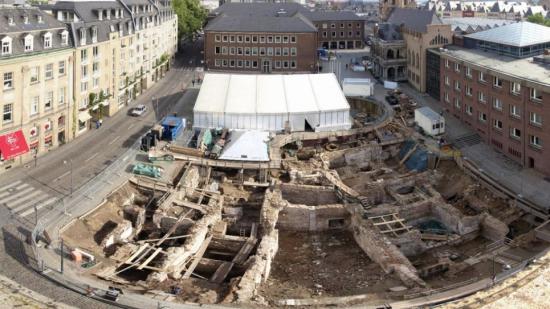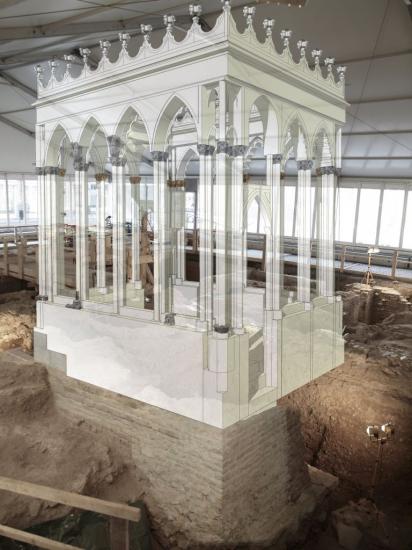Excavations in a city where Jews have lived as long as Christians yield some remarkable findings, to be displayed in a major new museum
Raphael Ahren
Source -http://www.timesofisrael.com/1700-years-of-jewish-history-come-alive-in-downtown-cologne/

Digging up a medieval Jewish quarter in the heart of Cologne (photo credit: Cologne Municipality)
Sometime between 1267 and 1349, Samuel Bar Zelig scratched his name onto the bimah (the platform from which the cantor leads the prayer and reads the Torah) of the local synagogue.
“Apparently the children learned and played there, and evidently also fooled around,” said Michael Wiehen, a senior archaeologist with the Cologne municipality.
In the Middle Ages, synagogues were often used as classrooms. In this particular house of worship, in the heart of Europe, the children apparently climbed on chairs and table to sign their names wherever they could, Wiehen explained. “They essentially wrote something like ‘I was here.’”
Samuel’s ancient “graffiti,” as archaeologists call this kind of scrawling, is only one of a myriad of relics that were — and are currently still being — excavated in a central Cologne square, the site of the city’s ancient synagogue. In a few years, the remaining ruins of that 700-year-old synagogue and the adjacent ancient mikveh, or ritual bath, will be visible to visitors in what promises to become one of Europe’s most fascinating museums of ancient and medieval Jewish history. Visitors will get see the base of the shul’s original bimah, and a modern reconstruction of it, in addition to many other relics found in Cologne’s medieval Jewish quarter.
More than 700 fragments of the ancient synagogue have been found, allowing the archaeologists to reconstruct the bimah. “It was probably created around 1280 by French workmen of the Cologne Cathedral lodge, which makes this Bimah a unique testimony to the cohabitation of Jews and Christians at that time,” the museum website states.
Several years in the planning, the Archaeological Zone/Jewish Museum, as the Cologne municipality calls the project, will be spread out over an area of more than 10,000 square meters (approximately 110,000 square feet). Besides the ancient shul, visitors will get to see (and learn about) ancient medallions, clay marbles and ivory dice, animal bones (which shed light on the Jews’ eating habits) and a Hebrew inscription above a private house that contained instructions about how the “feces are to be taken out.” Archaeologists also found countless slates with inscriptions, including one museum officials consider “a true historical sensation” — the oldest Yiddish writing on stone.

A reconstruction of the bimah in Cologne’s medieval synagogue. (photo credit: Cologne Municipality, Archaeological Zone: Ertan Özcan)
“We found slates that basically served as the notepads of the Jewish community before 1349,” Wiehen told The Times of Israel during a recent visit at the excavation site, where archaeologists are still digging in hopes of finding more clues on how Jews lived in the Middle Ages. “It was used to practice writing and also for literary texts, religious texts and poetry, but also for drawings and scribblings. What is possible the oldest old-Yiddish text in the world was found here.”
The slate he is referring to appears to contain a racy knight’s tale, written in an early Yiddish in Hebrew letters. “Our Jewish studies expert who’s dealing with this was exalted,” Wiehen said. “This is something truly amazing.”
The idea of another Jewish museum — an ambitious project which will cost local authorities up to €40 million, situated just meters away from the Cologne Cathedral, the city’s main landmark — had its share of controversy. The Archaeological Zone/Jewish Museum’s previous director was sent home after he publicly accused opponents of anti-Semitism. The leaders of the local Jewish community — which supports the project but insists it didn’t need it — do feel that the general public, let alone some far-right politicians, don’t like the idea of a huge Jewish museum in their city’s historic old city — especially one that demonstrates that Jews have been living in Cologne for centuries.
Indeed, Cologne is home to the oldest Jewish community north of the Alps. “Jews have probably lived in the province of Lower Germania since the end of the first century CE. By the fourth century they constituted a large and significant community,” according to the municipality.
In 321 CE — more than 650 years before the first Jews arrived in Prague — the residents of Cologne sent a letter to Emperor Constantine the Great, asking him whether they may admit Jewish residents to the town senate. Constantine said yes. (While a senate seat came with significant perks, it had to be bought with cash, hence the Christians’ interest in allowing Jews). Constantine’s 321 edict proves that Jews have lived in Cologne for more than 1,700 years — in other words, Judaism has existed in Cologne about just as long as Christianity. But where exactly the Jews lived is unclear; no archaeological evidence exists that shows a Jewish presence in the city before the ninth century, according to Marcus Trier, the director of Archaeological Zone/Jewish Museum, who also oversees the current excavations.
“That would still make Cologne the oldest proven Jewish existence in Germany,” he said. “The ninth century is still fantastically early.”

The heart of medieval Cologne’s Jewish quarter (photo credit: Cologne Municipality, Archeological Zone: Ertan Özcan)
In the Middle Ages, Cologne’s ancient synagogue stood in what was “one of the largest and even then, oldest urban Jewish Quarters,” according to the museum website. “The Carolingian Synagogue is built on a classical structure of the fourth century. An integral part of the monument is a basin that was used in a uniform manner in all subsequent phases of the building. Its 1,000-year long utilization was detected in thermoluminescence investigations. The finding could be an indicator for a synagogue that is even older.”
A virtual tour through medieval Cologne’s Jewish quarter — including the synagogue with its impressively ornamented bimah and the mikveh — is available on YouTube:
http://www.youtube.com/watch?v=CRZOMNsELNQ&noredirect=1#t=14